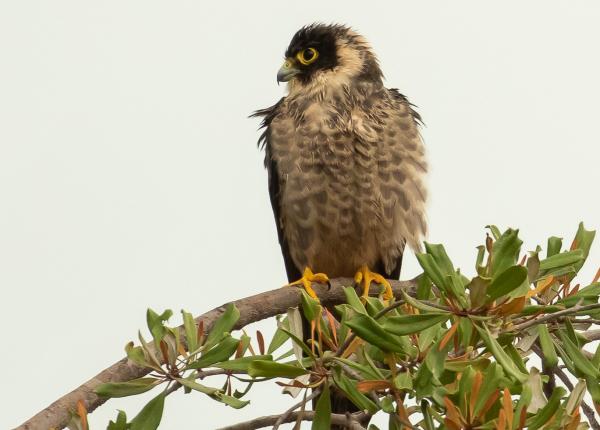Did You Know?
- One researcher working in Antananarivo, Madagascar, observed around 15 Sooty Falcons foraging on insects at dusk in the lights of a stadium during football matches
- This species is migratory
- In the winter, one might find several of these falcons hanging out together in small groups
How is The Peregrine Fund Helping
Though The Peregrine Fund doesn't work directly with Sooty Falcons, our scientists are working hard to learn about and protect all raptors and their habitats throughout much of Africa. Through environmental education efforts, we are also working to put a stop to the common practice of poisoning carcasses to kill large predators, which also kills a host of wildlife including vultures, eagles, and other scavenging birds. In Madagascar, we are working to protect important raptor habitat. These efforts will certainly benefit all raptors of the region, including the Sooty Falcon.
Meanwhile, our efforts in scientific research, habitat conservation, education, and community development help conserve birds of prey around the world. We also supply literature to researchers from our avian research library, which helps scientists around the world gather and share important information on raptor conservation. We also run the Global Raptor Impact Network which gives raptor researchers tools to more efficiently conduct their own studies while contributing to a global program. GRIN also provides citizen scientists a way to participate in raptor science and conservation.
Where They Live
Found mainly in parts of Africa and the Middle East, the Sooty Falcon nests in very dry habitats, sometimes those nearly free of vegetation. They nest on rocky outcrops on cliffs in rugged or mountainous desert areas and small, uninhabited desert islands, from sea level up to about 800 m. However, in the winter, it switches habitat type completely. During that time, it can be found in tropical or subtropical habitats, often close to water.
Why They Need our Help
The Sooty Falcon is categorized as Vulnerable. Some of the threats this lovely falcon faces including habitat destruction, especially in the form of human developments cropping up at important breeding sites, and disturbance. Feral cats also pose a threat to this falcon.
What They Eat
It feeds on a wide range of prey items including small birds (such as bee-eaters, swallows, orioles, small sea birds and more), bats, and flying insects (such as dragonflies, locusts, grasshoppers, flying ants, cicadas, and more). They often hunt in the air, catching prey on the wing, mostly in the late afternoon or early evening, or even at night. At times, several falcons may hunt together, chasing individual migrating birds at the same time.
Nests, Eggs, and Young
These falcons often nest on small, rocky islands in crevices in cliffs, sometimes on the ground beneath bushes, or in old nests built by other birds, such as ravens. The timing of the nesting season is relatively late (they often lay their eggs in July or August), but this is to coincide with the migration of small birds, which are an important food source for the young nestlings.
The female may lay between 1-4 eggs, which must be incubated for between 27-30 days. , and the chicks fledge 32-38 days later. The female handles incubation chores, and the male provides food for her and the nestlings. When the young first hatch, they are covered in white down. They grow quickly and will be ready to fly from the nest when they are around 5 weeks old.
This falcon can successfully breed when it is only one year old.
Sooty Falcon and the World Center for Birds of Prey
Though the World Center for Birds of Prey is far from the Sooty Falcon's range, we do have a number of interesting falcon species that serve as avian ambassadors during presentations and flight shows. American Kestrels, Peregrine and Aplomado Falcons, among others, can be seen at our center. We also offer many other fun ways to learn about birds of prey. The visitor center has interactive displays, tours, interesting videos and a children's room with activities from coloring sheets to quizzes to costumes and a touch table for the curious mind. Knowledgeable staff and volunteers are on hand to answer any questions you may have about Sooty Falcons or any other bird of prey.
References:
Global Raptor Information Network. 2022. Species account: Sooty Falcon Falco concolor. Downloaded from http://www.globalraptors.org on 14 Nov. 2022
Orta, J., G. M. Kirwan, P. F. D. Boesman, J. S. Marks, and C. J. Sharpe (2020). Sooty Falcon (Falco concolor), version 1.0. In Birds of the World (J. del Hoyo, A. Elliott, J. Sargatal, D. A. Christie, and E. de Juana, Editors). Cornell Lab of Ornithology, Ithaca, NY, USA.









